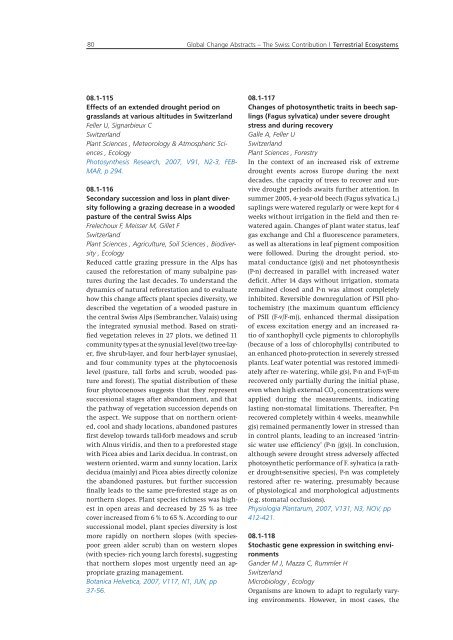Global Change Abstracts The Swiss Contribution - SCNAT
Global Change Abstracts The Swiss Contribution - SCNAT
Global Change Abstracts The Swiss Contribution - SCNAT
Create successful ePaper yourself
Turn your PDF publications into a flip-book with our unique Google optimized e-Paper software.
80<br />
08.1-115<br />
Effects of an extended drought period on<br />
grasslands at various altitudes in Switzerland<br />
Feller U, Signarbieux C<br />
Switzerland<br />
Plant Sciences , Meteorology & Atmospheric Sciences<br />
, Ecology<br />
Photosynthesis Research, 2007, V91, N2-3, FEB-<br />
MAR, p 294.<br />
08.1-116<br />
Secondary succession and loss in plant diversity<br />
following a grazing decrease in a wooded<br />
pasture of the central <strong>Swiss</strong> Alps<br />
Frelechoux F, Meisser M, Gillet F<br />
Switzerland<br />
Plant Sciences , Agriculture, Soil Sciences , Biodiversity<br />
, Ecology<br />
Reduced cattle grazing pressure in the Alps has<br />
caused the reforestation of many subalpine pastures<br />
during the last decades. To understand the<br />
dynamics of natural reforestation and to evaluate<br />
how this change affects plant species diversity, we<br />
described the vegetation of a wooded pasture in<br />
the central <strong>Swiss</strong> Alps (Sembrancher, Valais) using<br />
the integrated synusial method. Based on stratified<br />
vegetation releves in 27 plots, we defined 11<br />
community types at the synusial level (two tree-layer,<br />
five shrub-layer, and four herb-layer synusiae),<br />
and four community types at the phytocoenosis<br />
level (pasture, tall forbs and scrub, wooded pasture<br />
and forest). <strong>The</strong> spatial distribution of these<br />
four phytocoenoses suggests that they represent<br />
successional stages after abandonment, and that<br />
the pathway of vegetation succession depends on<br />
the aspect. We suppose that on northern oriented,<br />
cool and shady locations, abandoned pastures<br />
first develop towards tall-forb meadows and scrub<br />
with Alnus viridis, and then to a preforested stage<br />
with Picea abies and Larix decidua. In contrast, on<br />
western oriented, warm and sunny location, Larix<br />
decidua (mainly) and Picea abies directly colonize<br />
the abandoned pastures, but further succession<br />
finally leads to the same pre-forested stage as on<br />
northern slopes. Plant species richness was highest<br />
in open areas and decreased by 25 % as tree<br />
cover increased from 6 % to 65 %. According to our<br />
successional model, plant species diversity is lost<br />
more rapidly on northern slopes (with speciespoor<br />
green alder scrub) than on western slopes<br />
(with species- rich young larch forests), suggesting<br />
that northern slopes most urgently need an appropriate<br />
grazing management.<br />
Botanica Helvetica, 2007, V117, N1, JUN, pp<br />
37-56.<br />
<strong>Global</strong> <strong>Change</strong> <strong>Abstracts</strong> – <strong>The</strong> <strong>Swiss</strong> <strong>Contribution</strong> | Terrestrial Ecosystems<br />
08.1-117<br />
<strong>Change</strong>s of photosynthetic traits in beech saplings<br />
(Fagus sylvatica) under severe drought<br />
stress and during recovery<br />
Galle A, Feller U<br />
Switzerland<br />
Plant Sciences , Forestry<br />
In the context of an increased risk of extreme<br />
drought events across Europe during the next<br />
decades, the capacity of trees to recover and survive<br />
drought periods awaits further attention. In<br />
summer 2005, 4- year-old beech (Fagus sylvatica L.)<br />
saplings were watered regularly or were kept for 4<br />
weeks without irrigation in the field and then re-<br />
watered again. <strong>Change</strong>s of plant water status, leaf<br />
gas exchange and Chl a fluorescence parameters,<br />
as well as alterations in leaf pigment composition<br />
were followed. During the drought period, stomatal<br />
conductance (g(s)) and net photosynthesis<br />
(P-n) decreased in parallel with increased water<br />
deficit. After 14 days without irrigation, stomata<br />
remained closed and P-n was almost completely<br />
inhibited. Reversible downregulation of PSII photochemistry<br />
(the maximum quantum efficiency<br />
of PSII (F-v/F-m)), enhanced thermal dissipation<br />
of excess excitation energy and an increased ratio<br />
of xanthophyll cycle pigments to chlorophylls<br />
(because of a loss of chlorophylls) contributed to<br />
an enhanced photo-protection in severely stressed<br />
plants. Leaf water potential was restored immediately<br />
after re- watering, while g(s), P-n and F-v/F-m<br />
recovered only partially during the initial phase,<br />
even when high external CO 2 concentrations were<br />
applied during the measurements, indicating<br />
lasting non-stomatal limitations. <strong>The</strong>reafter, P-n<br />
recovered completely within 4 weeks, meanwhile<br />
g(s) remained permanently lower in stressed than<br />
in control plants, leading to an increased ‘intrinsic<br />
water use efficiency’ (P-n /g(s)). In conclusion,<br />
although severe drought stress adversely affected<br />
photosynthetic performance of F. sylvatica (a rather<br />
drought-sensitive species), P-n was completely<br />
restored after re- watering, presumably because<br />
of physiological and morphological adjustments<br />
(e.g. stomatal occlusions).<br />
Physiologia Plantarum, 2007, V131, N3, NOV, pp<br />
412-421.<br />
08.1-118<br />
Stochastic gene expression in switching environments<br />
Gander M J, Mazza C, Rummler H<br />
Switzerland<br />
Microbiology , Ecology<br />
Organisms are known to adapt to regularly varying<br />
environments. However, in most cases, the

















